Function-Based Design Principles for Additive Manufacturing
Abstract
:1. Introduction
2. Methodology
3. Design Principles for Additive Manufacturing
4. Case Study
5. Discussion
6. Conclusions & Future Work
Author Contributions
Funding
Institutional Review Board Statement
Informed Consent Statement
Data Availability Statement
Acknowledgments
Conflicts of Interest
References
- Gibson, I.; Rosen, D.; Stucker, B. Additive Manufacturing Technologies; Springer: New York, NY, USA, 2015; ISBN 978-1-4939-2112-6. [Google Scholar]
- EOS Antenna Bracket for RUAG‘s Sentinel Satellite—Certified for Use in Outer Space; Whitepaper. 2019. Available online: https://www.eos.info/01_parts-and-applications/case_studies_applications_parts/_case_studies_pdf/en_cases/cs_m_aerospace_ruag_en.pdf (accessed on 15 February 2022).
- EOS Flow Measurement Probes from Vectoflow—Highly Robust Thanks to Additive Manufacturing and EOS. 2018. Available online: https://www.eos.info/en/all-3d-printing-applications/ruag-aerospace-3d-printed-satellite-components (accessed on 15 February 2022).
- Laverne, F.; Segonds, F.; Anwer, N.; le Coq, M. Assembly Based Methods to Support Product Innovation in Design for Additive Manufacturing: An Exploratory Case Study. J. Mech. Des. 2015, 137, 121701. [Google Scholar] [CrossRef]
- Wiberg, A.; Persson, J.; Ölvander, J. Design for Additive Manufacturing—A Review of Available Design Methods and Software. Rapid Prototyp. J. 2019, 25, 1080–1094. [Google Scholar] [CrossRef] [Green Version]
- Pahl, G.; Beitz, W.; Feldhusen, J.; Grote, K.-H. Engineering Design; Springer: London, UK, 2007; ISBN 978-1-84628-318-5. [Google Scholar]
- Pradel, P.; Zhu, Z.; Bibb, R.; Moultrie, J. Investigation of Design for Additive Manufacturing in Professional Design Practice. J. Eng. Des. 2018, 29, 165–200. [Google Scholar] [CrossRef] [Green Version]
- Bin Maidin, S.; Campbell, I.; Pei, E. Development of a Design Feature Database to Support Design for Additive Manufacturing. Assem. Autom. 2012, 32, 235–244. [Google Scholar] [CrossRef] [Green Version]
- Perez, K.B.; Anderson, D.S.; Hölttä-Otto, K.; Wood, K.L. Crowdsourced Design Principles for Leveraging the Capabilities of Additive Manufacturing. In Proceedings of the 20th International Conference on Engineering Design (ICED15), Milan, Italy, 27–30 July 2015; The Design Society: Milan, Italy, 2015; pp. 1–10. [Google Scholar]
- Lauff, C.A.; Perez, K.B.; Camburn, B.A.; Wood, K.L. Design Principle Cards: Toolset to Support Innovations with Additive Manufacturing. In Proceedings of the 24th Design for Manufacturing and the Life Cycle Conference; 13th International Conference on Micro- and Nanosystems, Anaheim, CA, USA, 18–21 August 2019; Volume 4. [Google Scholar]
- Hwang, D.; Blake Perez, K.; Anderson, D.; Jensen, D.; Camburn, B.; Wood, K. Design Principles for Additive Manufacturing: Leveraging Crowdsourced Design Repositories. J. Mech. Des. 2021, 143, 072005. [Google Scholar] [CrossRef]
- Weiss, F.; Binz, H.; Roth, D. Conception of a Design Catalogue for the Development of Functionalities with Additive Manufacturing. In Proceedings of the DS 85-2: Proceedings of NordDesign 2016, Trondheim, Norway, 10–12 August 2016; Boks, C., Sigurjonsson, J., Steinert, M., Vis, C., Wulvik, A., Eds.; The Design Society: Trondheim, Norway, 2016; Volume 2, pp. 002–011. [Google Scholar]
- Roth, K. Konstruieren Mit Konstruktionskatalogen; Springer: Berlin/Heidelberg, Germany, 2001; ISBN 978-3-642-62100-0. [Google Scholar]
- Schumacher, F.; Watschke, H.; Kuschmitz, S.; Vietor, T. Goal Oriented Provision of Design Principles for Additive Manufacturing to Support Conceptual Design. In Proceedings of the Design Society: International Conference on Engineering Design, Delft, The Netherlands, 5–8 August 2019; Volume 1, pp. 749–758. [Google Scholar] [CrossRef] [Green Version]
- Watschke, H.; Kuschmitz, S.; Heubach, J.; Lehne, G.; Vietor, T. A Methodical Approach to Support Conceptual Design for Multi-Material Additive Manufacturing. In Proceedings of the Design Society: International Conference on Engineering Design, Delft, The Netherlands, 5–8 August 2019; Volume 1, pp. 659–668. [Google Scholar] [CrossRef] [Green Version]
- Blösch-Paidosh, A.; Shea, K. Design Heuristics for Additive Manufacturing. In Proceedings of the DS 87-5: Proceedings of the 21st International Conference on Engineering Design (ICED 17) Vol 5: Design for X, Design to X, Vancouver, BC, Canada, 21–25 August 2017; The Design Society: Vancouver, BC, Canada, 2017; pp. 91–100. [Google Scholar]
- Lindwall, A.; Törlind, P. Evaluating Design Heuristics for Additive Manufacturing as an Explorative Workshop Method. In Proceedings of the DS 92: Proceedings of the DESIGN 2018 15th International Design Conference, Dubrovnik, Croatia, 21–24 May 2018; The Design Society: Dubrovnik, Croatia, 2018; pp. 1221–1232. [Google Scholar]
- Blösch-Paidosh, A.; Shea, K. Enhancing Creative Redesign through Multimodal Design Heuristics for Additive Manufacturing. J. Mech. Des. 2021, 143, 102003. [Google Scholar] [CrossRef]
- Blösch-Paidosh, A.; Shea, K. Design Heuristics for Additive Manufacturing Validated Through a User Study. J. Mech. Des. 2019, 141, 041101. [Google Scholar] [CrossRef]
- Hubka, V.; Eder, W.E. Theory of Technical Systems; Springer: Berlin/Heidelberg, Germany, 1988; ISBN 978-3-642-52123-2. [Google Scholar]
- Otto, K.N.; Wood, K.L. Product Design: Techniques in Reverse Engineering and New Product Development; Prentice Hall: Hoboken, NJ, USA, 2001. [Google Scholar]
- Dym, C.L.; Little, P.; Orwin, E.J. Engineering Design: A Project-Based Introduction, 4th ed.; Wiley: Hoboken, NJ, USA, 2014; ISBN 978-1-118-32458-5. [Google Scholar]
- Ulrich, K.D.; Eppinger, S.D.; Yang, M.C. Product Design and Development, 7th ed.; McGraw-Hill Education: New York, NY, USA, 2020; ISBN 978-1-260-04365-5. [Google Scholar]
- Ullman, D.G. The Mechanical Design Process, 4th ed.; McGraw-Hill: New York, NY, USA, 2010; ISBN 978-0-07-297574-1. [Google Scholar]
- Erden, M.S.; Komoto, H.; van Beek, T.J.; D’Amelio, V.; Echavarria, E.; Tomiyama, T. A Review of Function Modeling: Approaches and Applications. Artif. Intell. Eng. Des. Anal. Manuf. 2008, 22, 147–169. [Google Scholar] [CrossRef] [Green Version]
- Verma, M.; Wood, W.H. Form Follows Function: Case-Based Learning over Product Evolution. In Proceedings of the 6th Design for Manufacturing Conference, Pittsburgh, PA, USA, 9–12 September 2001; Volume 3, pp. 219–229. [Google Scholar]
- Fu, K.K.; Yang, M.C.; Wood, K.L. Design Principles: Literature Review, Analysis, and Future Directions. J. Mech. Des. 2016, 138, 101103. [Google Scholar] [CrossRef] [Green Version]
- Valjak, F.; Bojčetić, N. Conception of Design Principles for Additive Manufacturing. In Proceedings of the Design Society: International Conference on Engineering Design, Delft, The Netherlands, 5–8 August 2019; Volume 1, pp. 689–698. [Google Scholar] [CrossRef] [Green Version]
- Kurtoglu, T.; Campbell, M.I. Automated Synthesis of Electromechanical Design Configurations from Empirical Analysis of Function to Form Mapping. J. Eng. Des. 2009, 20, 83–104. [Google Scholar] [CrossRef]
- Singh, V.; Skiles, S.M.; Krager, J.E.; Wood, K.L.; Jensen, D.; Sierakowski, R. Innovations in Design Through Transformation: A Fundamental Study of Transformation Principles. J. Mech. Des. 2009, 131, 081010. [Google Scholar] [CrossRef] [Green Version]
- Yilmaz, S.; Seifert, C.M. Cognitive Heuristics in Design Ideation. In Proceedings of the International Engineering Design Conference—Design 2010, Trondheim, Norway, 2–3 September 2010; The Design Society: Dubrovnik, Croatia, 2010. [Google Scholar]
- McAdams, D.A. Identification and Codification of Principles for Functional Tolerance Design. J. Eng. Des. 2003, 14, 355–375. [Google Scholar] [CrossRef]
- Novak, R. Razvoj Konstrukcijskih Principa Temeljenih na Mogućnostima DMLS Proizvodnog Postupka, in Croatian (English Development of Design Principles Based on DMLS Manufacturing Process). Master’s Thesis, University of Zagreb, Zagreb, Croatia, 2021. [Google Scholar]
- Hirtz, J.; Stone, R.B.; McAdams, D.A.; Szykman, S.; Wood, K.L. A Functional Basis for Engineering Design: Reconciling and Evolving Previous Efforts. Res. Eng. Des. 2002, 13, 65–82. [Google Scholar] [CrossRef]
- Caldwell, B.W.; Sen, C.; Mocko, G.M.; Summers, J.D. An Empirical Study of the Expressiveness of the Functional Basis. Artificial Intell. Eng. Des. Anal. Manuf. 2011, 25, 273–287. [Google Scholar] [CrossRef]
- Sen, C.; Summers, J.D.; Mocko, G.M. Physics-Based Reasoning in Conceptual Design Using a Formal Representation of Function Structure Graphs. J. Comput. Inf. Sci. Eng. 2013, 13, 011008. [Google Scholar] [CrossRef]
- Lukić, M. Optimiranje Polimernih Milireaktora Izrađenih Aditivnom Proizvodnjom, in Croatian (English Optimization of Polymeric Millireactors Produced by Additive Manufacturing). Ph.D. Thesis, University of Zagreb, Zagreb, Croatia, 2021. [Google Scholar]
- Teegavarapu, S.; Summers, J.D.; Mocko, G.M. Case Study Method for Design Research: A Justification. In Proceedings of the 20th International Conference on Design Theory and Methodology; Second International Conference on Micro- and Nanosystems, Brooklyn, NY, USA, 3–6 August 2008; Volume 4, pp. 495–503. [Google Scholar]
- Rešetar, M. Primjena 3D Skeniranja i DMLS Postupka Aditivne Proizvodnje u Povratnom Inženjerstvu, in Croatian (English Application of 3D Scanning and DMLS Manufacturing Process in Reversable Engineering). Bachelor’s Thesis, University of Zagreb, Zagreb, Croatia, 2022. [Google Scholar]
- Klein Blösch, A. Design Heuristics for Additive Manufacturing. Ph.D. Thesis, ETH Zürich, Zürich, Switzerland, 2020. [Google Scholar]
- Hwang, D.; Lauff, C.A.; Perez, K.B.; Camburn, B.A.; Wood, K.L. Comparing the Impacts of Design Principles for Additive Manufacturing on Student and Experienced Designers. Int. J. Eng. Educ. 2020, 36, 1862–1876. [Google Scholar]
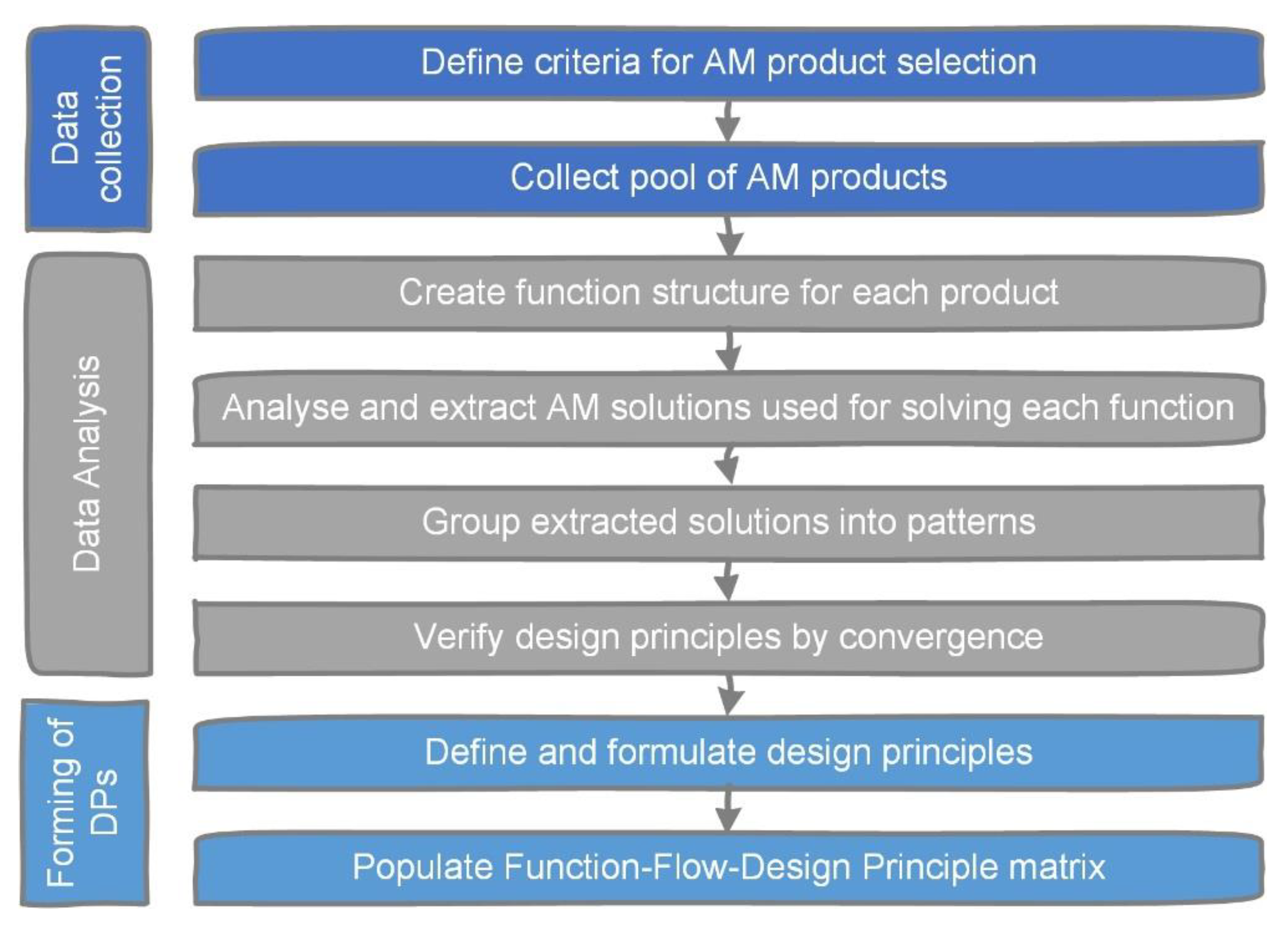
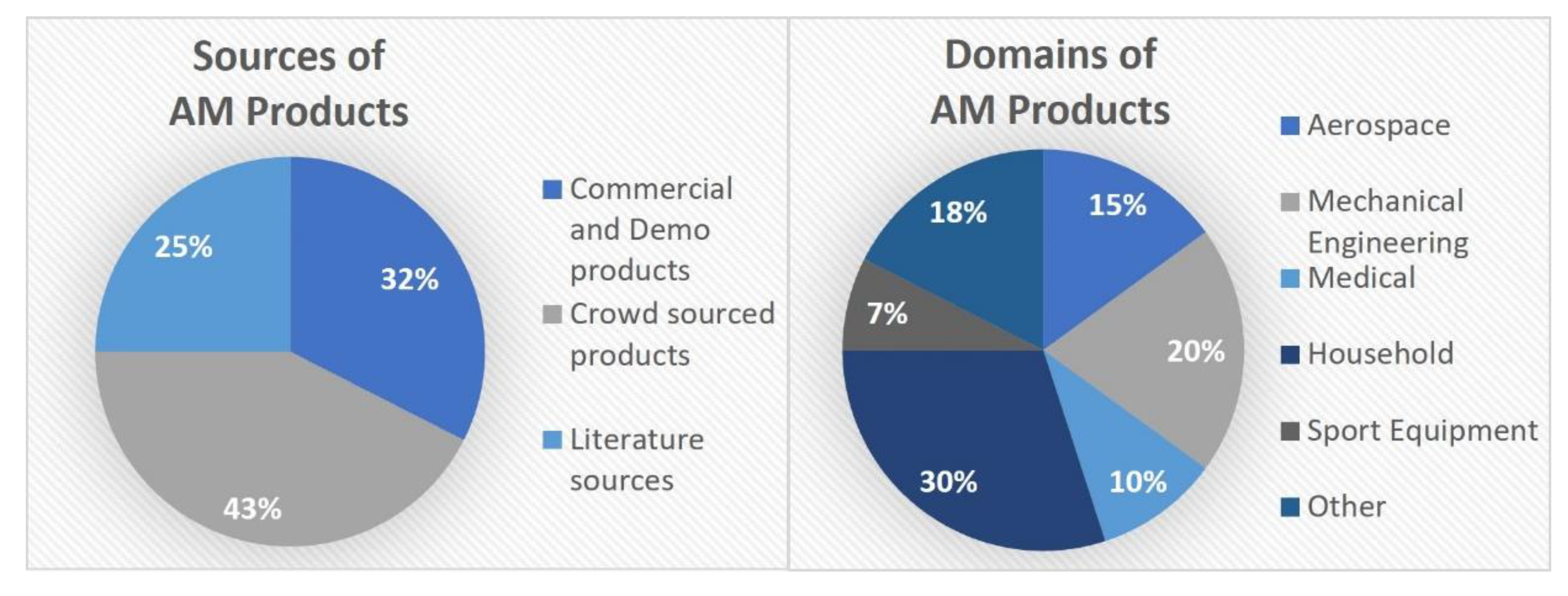
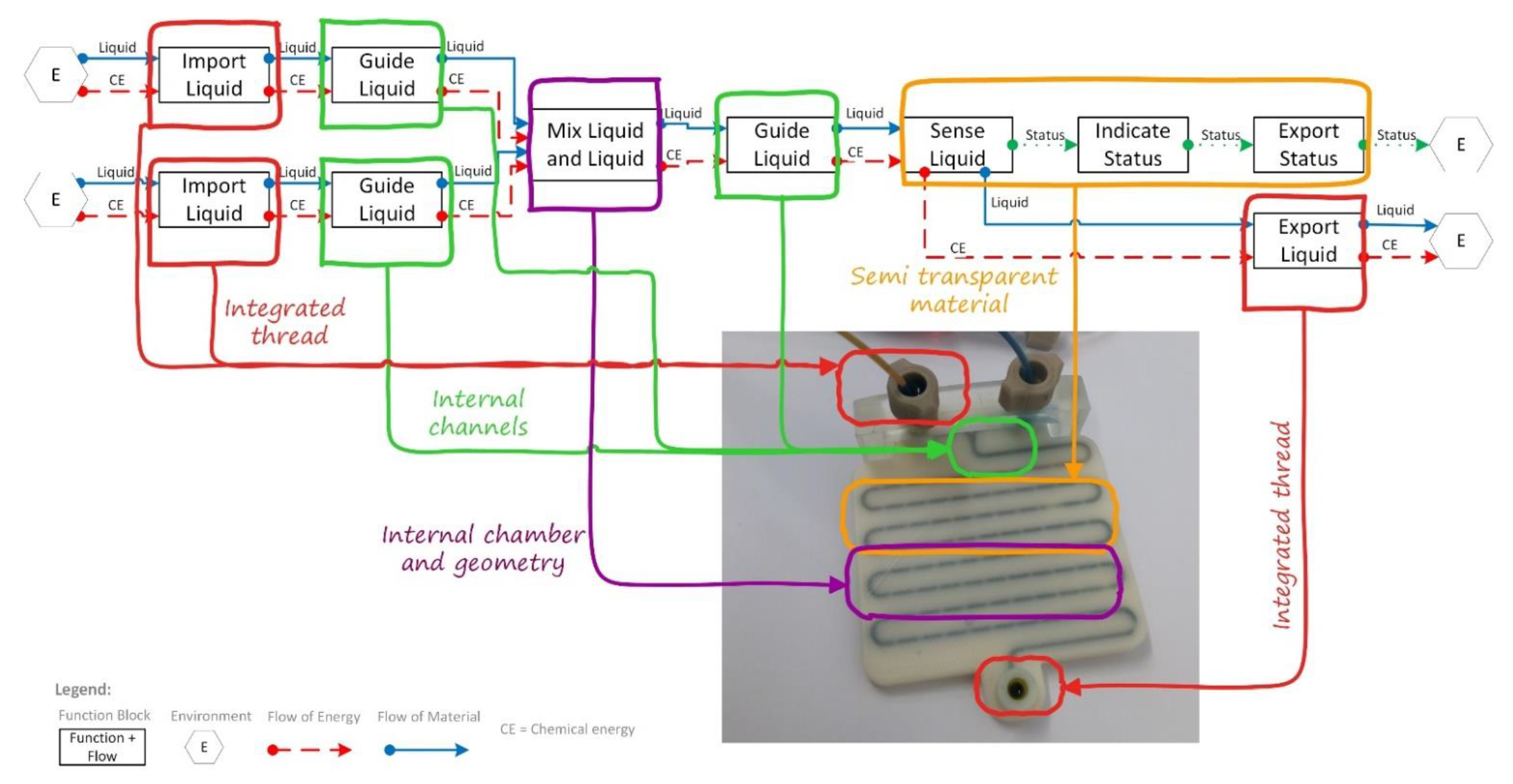
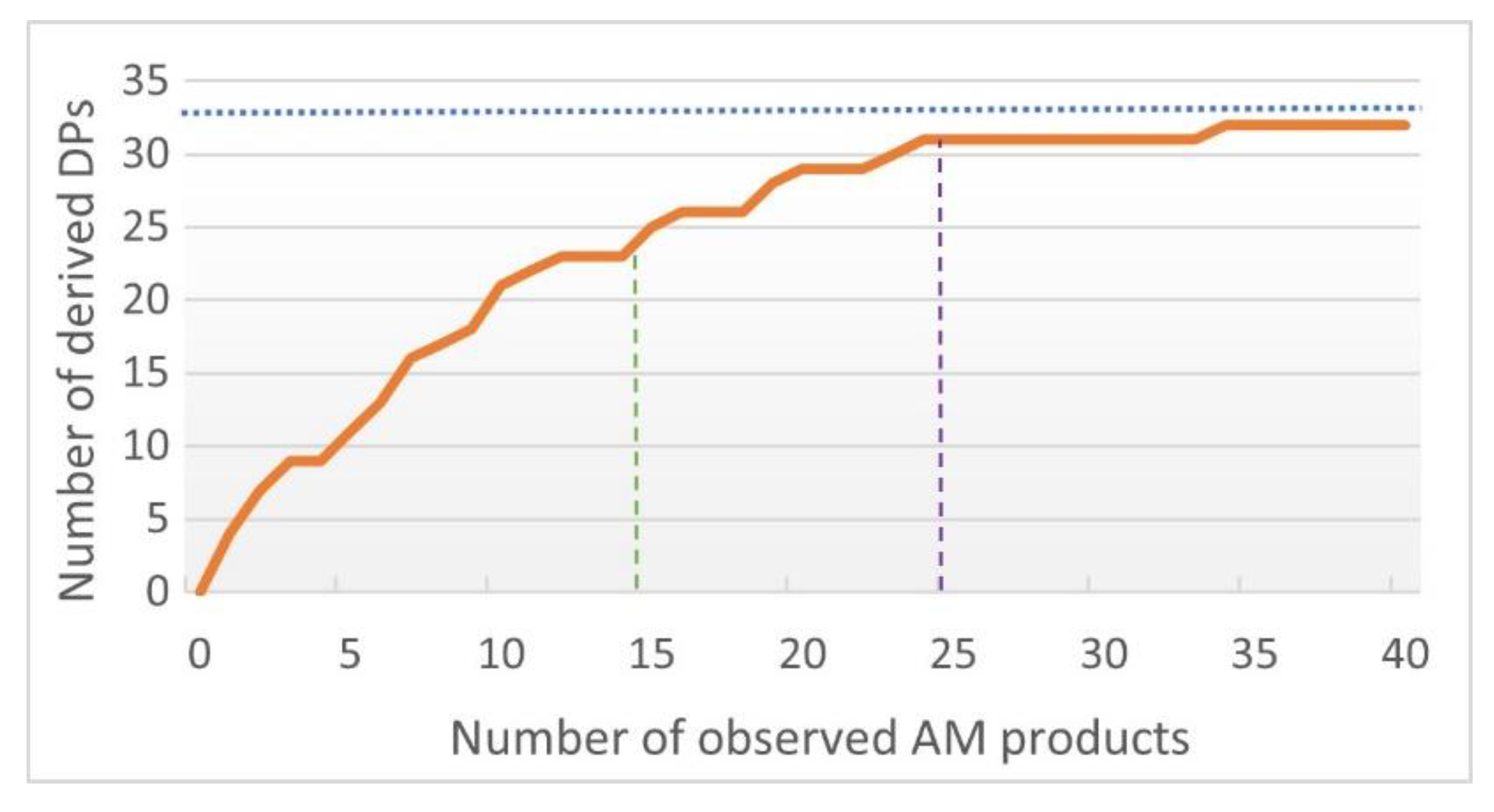
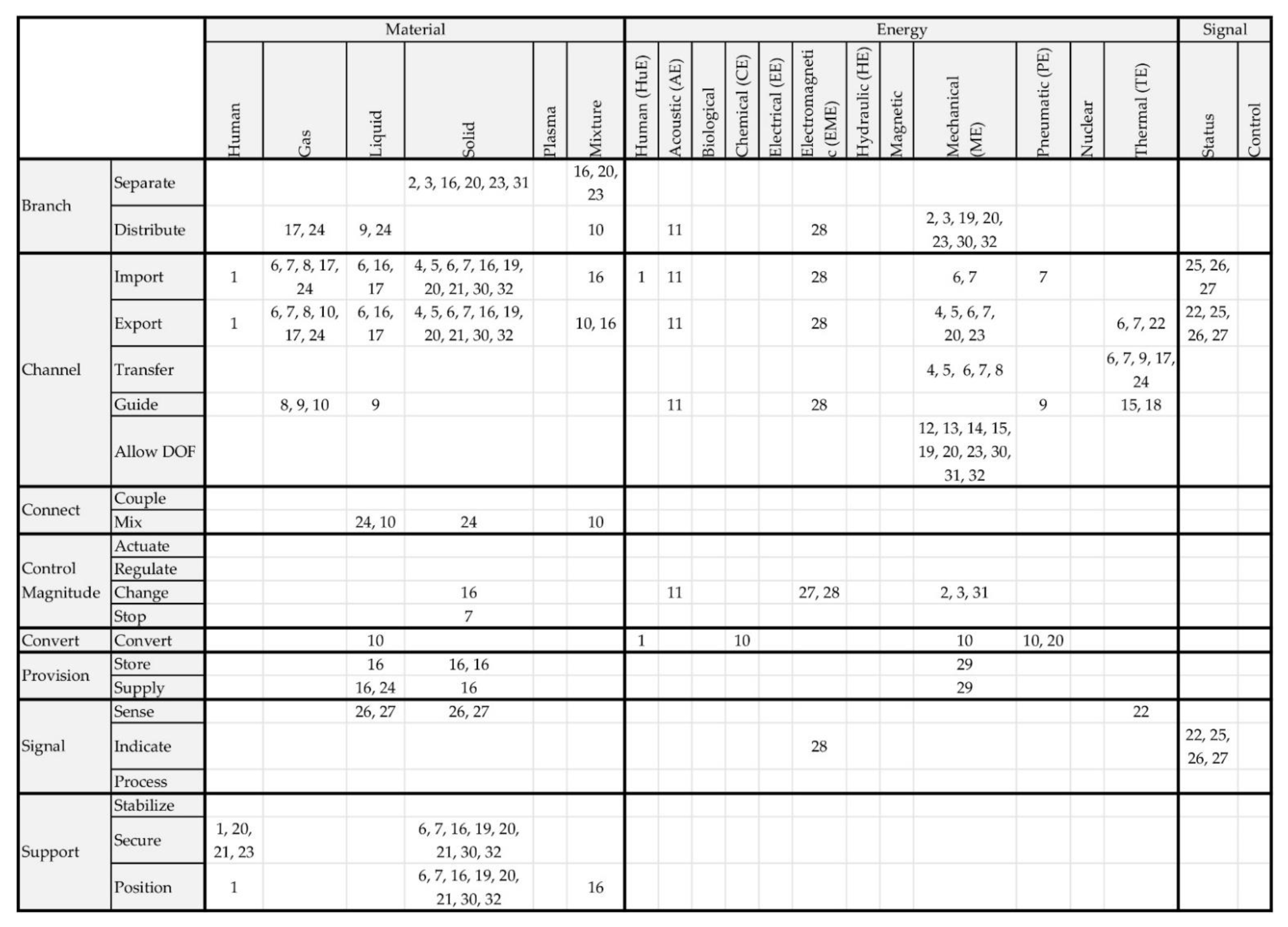


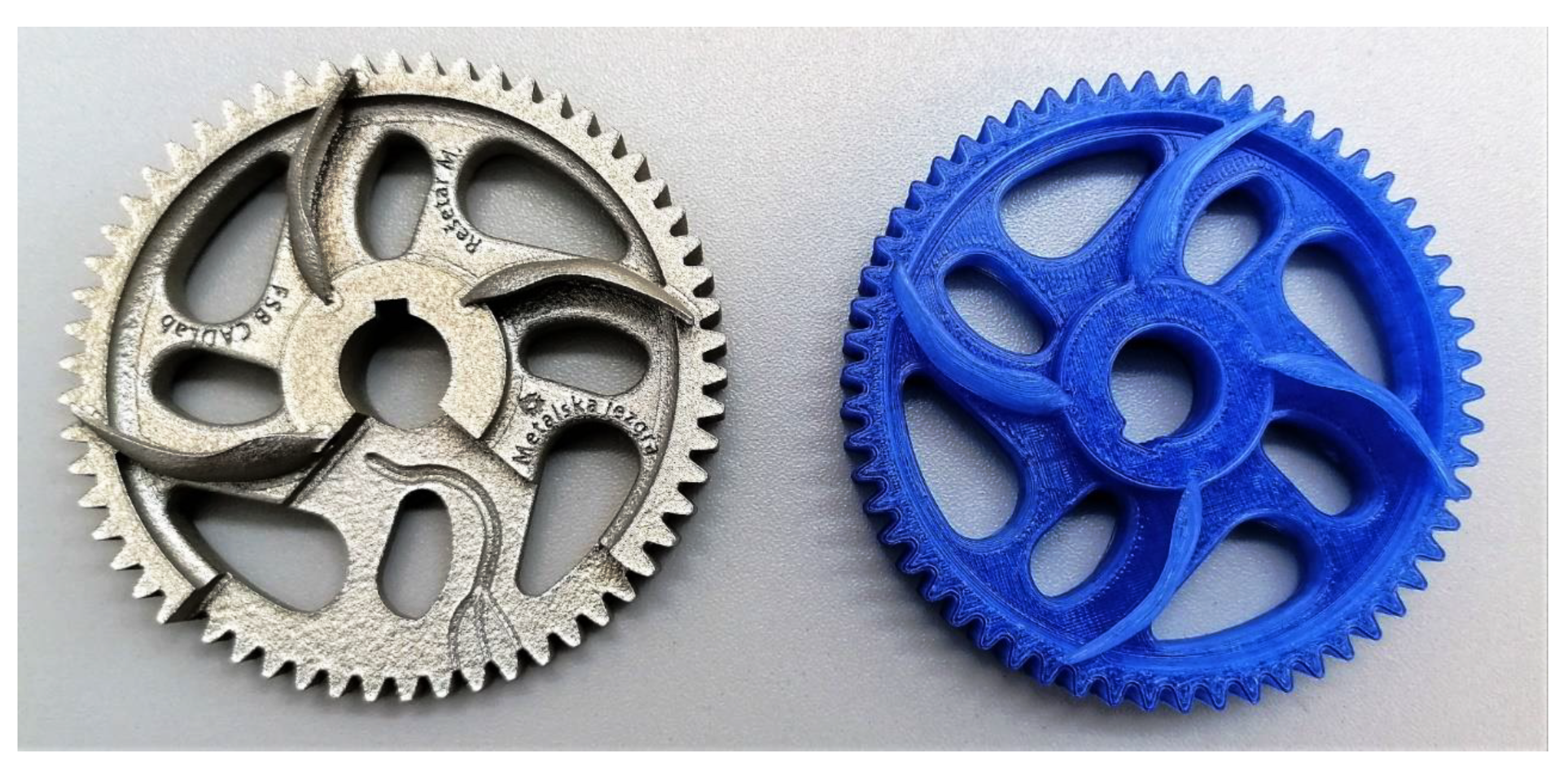
| # | Design Principles for AM |
|---|---|
| #DP1 | Fit user by using custom ergonomic geometry AM enables manufacturing of complex and curved geometry. Furthermore, each product manufactured with AM can have different geometry. Therefore, the geometry in interaction with the user can be easily customised for an individual user or different groups of users to provide an optimum ergonomic. |
| #DP2 | Absorb energy by using lattice structures AM enables easy manufacturing of lattice structures, on multiple levels of hierarchy, through the entire geometry or only in part of the geometry. The lattice structure can absorb energy through elastic or plastic movement, deformation, or breakage. |
| #DP3 | Absorb energy by using elastic material AM can process a variety of materials with different material properties. Create structures using a material with adequate elasticity to absorb energy. |
| #DP4 | Enhance interaction with environment by customising surface texture With AM, it is relatively easy to manufacture different patterns and textures embedded in the surface of the product. Create customised textures to ensure good grip and interaction with the environment. |
| #DP5 | Enhance interaction with environment by using customised surface features With AM, it relatively easy to manufacture small 3D features on the surface of the products. Create custom features to provide an adequate interaction with the environment. |
| #DP6 | Enable interaction with environment by integrating standard geometry AM can be used to create simple shapes, replicate existing geometry, and integrate multiple features in a single design. Utilise this possibility of AM and integrate a standard geometry (e.g., threads, bores) into a design to enable interaction with the environment and connection with other products. |
| #DP7 | Enable interaction with environment by using custom geometry to fit the use case AM enables easy customisation of geometry. Customise geometry for the particular use case to enable interaction with the environment and direct fit with the geometry of other components. |
| #DP8 | Enhance fluid performance by using customised surfaces AM can manufacture complex shapes. Use this possibility of AM when interacting with fluids to create surfaces whose shape will be in accordance with fluid dynamics to increase the overall performance. |
| #DP9 | Enhance fluid performance by using integrated internal channels AM enables the creation of complex internal geometry. Use the custom internal channels whose shape will be in accordance with fluid dynamics for guiding and distributing fluids to increase the overall performance. |
| #DP10 | Enhance material/energy conversion by shaping internal chamber for the use case AM enables the creation of complex internal geometry. Create custom internal chambers with geometry that will be adjusted for a particular physical process happening inside the chamber, such as energy or material conversion. |
| #DP11 | Enhance energy magnitude by shaping internal chamber for the use case AM enables the creation of complex internal geometry. Create custom internal chambers with geometry that will help change the magnitude of the energy (e.g., increase/decrease pressure, change acoustic or kinetic energy). |
| #DP12 | Conduct mechanical energy and forces by applying lattice structures AM enables easy manufacturing of lattice structures, on multiple levels of hierarchy, through the entire geometry or only in part of the geometry. Use the lattice structures to conduct mechanical energy through the product and create a lightweight but stiff product. |
| #DP13 | Conduct mechanical energy and forces by applying topologically optimised geometry AM enables manufacturing of complex geometries. Use this possibility to create topologically optimised geometry to create optimised designs with reduced mass and/or increased performance that will conduct mechanical energy or forces. |
| #DP14 | Conduct mechanical energy and forces by using void structures AM enables manufacturing of complex geometries. Use this possibility to create void structures to conduct mechanical energy or forces with reduced weight. |
| #DP15 | Conduct energy by using material with appropriate properties AM processes can utilise a variety of different materials. Use appropriate material for the use case. |
| #DP16 | Interact with object or material by customising geometry for the use case AM enables easy customisation of geometry. Customise geometry for the particular use case to enable interaction with the object of interest to ensure an adequate fit. |
| #DP17 | Import/export fluid by applying appropriate openings With AM, it is easy to create custom openings on the surface. Customise the openings according to fluid dynamics to increase the overall performance during import or export of fluids from the system. |
| #DP18 | Conduct energy by embracing anisotropy and layered structure One of the characteristics of most AM processes is the anisotropic properties in a final product. Utilise the product orientation a layer like structure to increase the strength of the part in the direction of energy flow. |
| #DP19 | Enable movement of the system by using compliant mechanism Compliant mechanisms enable desired motions through relative flexibility of the mechanism shape. The AM capability of manufacturing complex shapes with varying wall thickness provides a means to create custom 2D and 3D single-body compliant mechanisms. |
| #DP20 | Achieve degree of freedom/desired behaviour by applying custom material distribution AM enables manufacturing of shapes with varying wall thicknesses. Use the material distribution to achieve movement and desired behaviour with the relative movement of a single body part. |
| #DP21 | Solve function with non-AM component by using integrated attachment point/geometry Sometimes AM cannot solve the product function, or the function can be solved more easily or cheaply with a non-AM component. Use the customisability of AM to create an attachment point or geometry for easy integration of non-AM components into a product. |
| #DP22 | Detect and indicate temperature change by using thermal sensitive material AM can process a variety of materials, including thermal sensitive polymers. Use thermal sensitive polymer to indicate a change in temperature to the user without the need for a dedicated sensor. |
| #DP23 | Connect another part or flexible end of a part by using integrated attachment point/geometry When a multi-part design or part opening is needed to solve the function, integrate the attachments into a product to ease the assembly and disassembly without the need for additional fastening elements. |
| #DP24 | Allow pass through of fluid by using lattice structures AM enables easy manufacturing of lattice structures on multiple levels of hierarchy, through the entire geometry or only in part of the geometry. Use the lattice structures to allow the pass through of fluid over a larger surface area. |
| #DP25 | Convey information with colour by using multicolour AM Some AM processes are capable of building multi-material structures. Use the multi-material capability to embed and convey information through colour. |
| #DP26 | Convey information by customising geometry AM enables easy manufacturing of complex geometry on multiple levels of hierarchy. Use custom geometry to convey information to the user by embedding it directly to the part. |
| #DP27 | Convey information and/or change permutability of light by applying custom material distribution In AM, there is no need for uniform wall thickness. Use material distribution to control permutability of light to embed the information that will be conveyed to the user when the part will be in front of the light source. |
| #DP28 | Conduct light by using transparent material AM can process a variety of materials, including transparent and semi-transparent materials. Use transparent materials to conduct and distribute light customised for the use case. |
| #DP29 | Store energy by using material elasticity With AM, it is possible to create custom structures that will act as a spring due to their shape and elasticity. Use such structures to store mechanical energy. |
| #DP30 | Provide movement by using single build assemblies AM can build entire assemblies in a single build without the need for additional assembly operations. Use these capabilities to connect multiple parts and enable movement of the product. |
| #DP31 | Change motion or force by using single build mechanisms AM can build entire mechanisms in a single build without the need for additional assembly operations. Use these capabilities to create entire mechanisms in a single build that will control the motion or change the force/energy in a predetermined manner. |
| #DP32 | Achieve desired behaviour by using multi-material AM Some AM processes are capable of building multi-material structures. Use the multi-material capability to design different properties in different areas of the part to achieve desired behaviour (e.g., flexible area vs. stiff area to achieve controlled flexibility of the part) |
Publisher’s Note: MDPI stays neutral with regard to jurisdictional claims in published maps and institutional affiliations. |
© 2022 by the authors. Licensee MDPI, Basel, Switzerland. This article is an open access article distributed under the terms and conditions of the Creative Commons Attribution (CC BY) license (https://creativecommons.org/licenses/by/4.0/).
Share and Cite
Valjak, F.; Kosorčić, D.; Rešetar, M.; Bojčetić, N. Function-Based Design Principles for Additive Manufacturing. Appl. Sci. 2022, 12, 3300. https://doi.org/10.3390/app12073300
Valjak F, Kosorčić D, Rešetar M, Bojčetić N. Function-Based Design Principles for Additive Manufacturing. Applied Sciences. 2022; 12(7):3300. https://doi.org/10.3390/app12073300
Chicago/Turabian StyleValjak, Filip, Dora Kosorčić, Marija Rešetar, and Nenad Bojčetić. 2022. "Function-Based Design Principles for Additive Manufacturing" Applied Sciences 12, no. 7: 3300. https://doi.org/10.3390/app12073300





